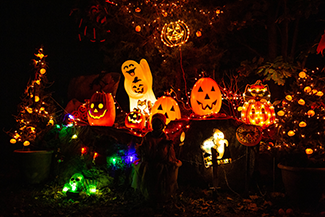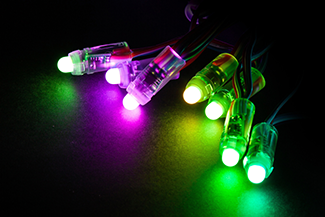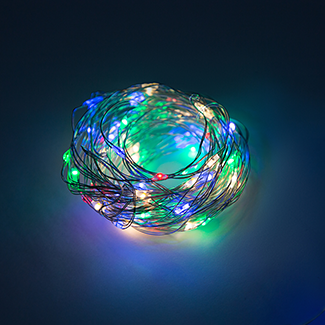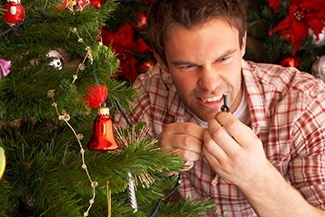Inspecting Holiday Lights
Inspecting Holiday Lights
Hello October! The holiday decorating season is underway! With Halloween just four weeks away and Christmas not far behind, it’s time to pull out and inspect your Halloween and Christmas lights.

If you haven’t already done so, it’s time to switch from traditional glass bulb lights to LED lights.
LED or Light Emitting Diode technology was introduced in the mid-1960s. Yet it’s only been since the 2000s that LED technology has been available in the general consumer market.
LED lighting products produce light up to 90% more efficiently than incandescent light bulbs. An electric current passes through a microchip, which illuminates the tiny light sources, the LEDs, resulting in visible light.
The useful life of LED lighting products is defined differently than that of other light sources, such as incandescent or compact fluorescent lighting (CFL). LEDs typically do not “burn out” or fail. Instead, they experience ‘lumen depreciation’, wherein the brightness of the LED dims slowly over time. Unlike incandescent bulbs, LED “lifetime” is established on a prediction of when the light output decreases by 30 percent.
Because LEDs emit light in a specific direction, unlike incandescent and CFL, which emit light and heat in all directions, they use light and energy more efficiently in a multitude of applications . . . such as holiday lights!
The Pros of LED Holiday lights
 There are many upsides to switching to LED holiday lights. Energy.gov tells us that LEDs consume far less electricity than incandescent bulbs, and decorative LED light strings such as Christmas tree lights are no different. Not only do LED holiday lights consume less electricity, they also have the following advantages:
There are many upsides to switching to LED holiday lights. Energy.gov tells us that LEDs consume far less electricity than incandescent bulbs, and decorative LED light strings such as Christmas tree lights are no different. Not only do LED holiday lights consume less electricity, they also have the following advantages:
Harder To Break
Unlike incandescent holiday lights, LED bulb caps are made from plastic, so they are much more durable. The LED light itself is made with epoxy lenses, not glass, and are much more resistant to breakage.
You don’t have to worry about dropping them off the roof and breaking them. Most LED lights will survive the fall and still work.
Longer Lasting
If you have any experience with incandescent Christmas lights, you’ll know they only last a year or two before they start going out. It can be a real hassle to buy new Christmas lights every year. With LED Christmas lights, you don’t have to do that anymore.
LED lights can last up to 10 years before they stop working, some people even claim they can last 20 years. Energy.gov notes that the same LED string could still be in use 40 holiday seasons from now. Talk about bang for your buck!
They Don’t Overheat
 LED holiday lights don’t have filaments that overheat and burnout. Therefore, they don’t overheat, and greatly reduce your risk of being caught in a Christmas tree-related fire.
LED holiday lights don’t have filaments that overheat and burnout. Therefore, they don’t overheat, and greatly reduce your risk of being caught in a Christmas tree-related fire.
Easier to Install
Up to 25 strings of LEDs can be connected end-to-end without overloading a wall socket. But before plugging them in, be sure your power cord strip is in good condition.
Many Different Shapes And Sizes
You can buy different LED Christmas lights for each part of your house. Whether you want small lights, colored lights, lights that change color on their own, controlled lights, you can find an LED light to match your preference.
How To fix LED Light Strands
The time to inspect and repair your holiday lights is now, not the day of the Halloween or Christmas party.
Let’s get started.
Testing, Testing, 123, Testing
Test every strand before hanging them in and on your house or wrap them around trees.
If one of the LED light strands isn’t working, it’s probably because of a bad bulb. If one bulb dies, the rest of the strand may not work. The only way to fix the problem is to find the bad bulb.
Sometimes it will be obvious which one is out, but if the whole strand is dark, you may need to pull off each bulb one at time, replace it with a good bulb, and plug in the strand.
Look For Corrosion
 If you replace all the bulbs and the lights still don’t work, you probably have a corroded terminal.
If you replace all the bulbs and the lights still don’t work, you probably have a corroded terminal.
Each light bulb has its own terminal that delivers the charge and makes it light up. Over time they can give out. Locating a bad terminal is the same as finding a bad bulb. Take every bulb out, look into the terminal, and see if it has corroded. If you find corrosion, you can clean it away with a small file or brush to get the bulb working again.
Tighten Loose Bulbs
Go through the strand(s) and feel for loose bulbs. Push loose ones back into place.
Note that these methods only work on lights that have removable lightbulbs. LED lights that don’t have removable bulbs are more difficult and dangerous to fix. Dump them and buy a new strand.
IMPORTANT: Always refer to the manufacturer’s product information to determine before hanging lights.
If everyone switched from incandescent mini-lights to energy-efficient LEDs this Christmas, carbon emissions would be reduced by 400,000 tons per year... and that would make for a very Merry Christmas!
Home Maintenance To-Do | #LEDbulbs
Podcast
The most desired improvements wanted in a kitchen remodel? We talk about the top 3! Plus questions about toilet issues, home remedies for cleaning waste lines, prepping a ceiling fan before removing popcorn ceiling, Weekly To Do on LED Bulbs for holiday decorations and more!
###
Photo Credit
- Shutterstock
Related Content
- Blog: Want To Join The Led Revolution?
- DIY FAQ: Lights! Cabinet! Action!
- DIY FAQ: Four DIY Projects That Help Pay For Themselves
- DIY FAQ: To Led Or Not To Led
- DIY FAQ: How Do LEDs Compare With Traditional Christmas Lights?
- External Resource: Energy Star
